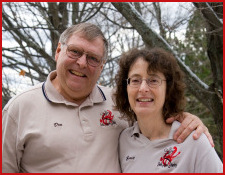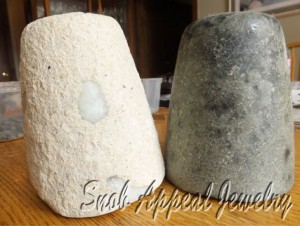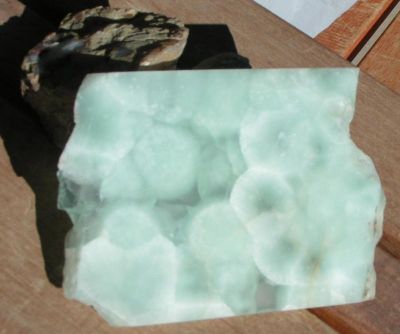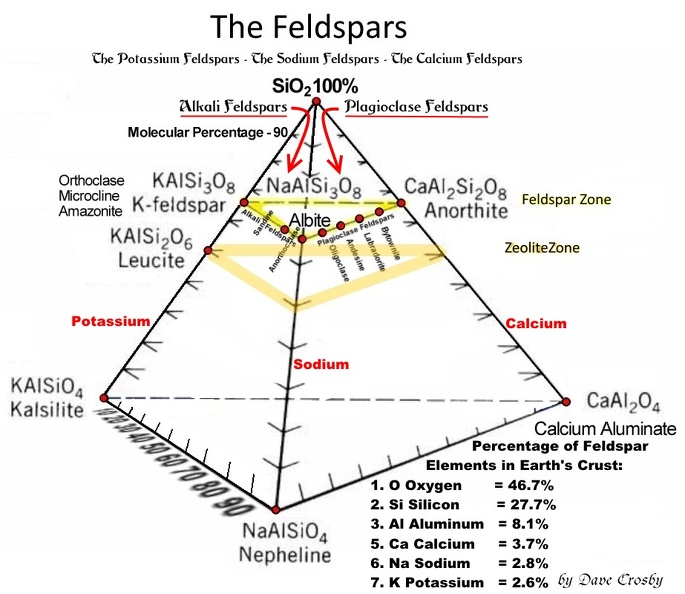|
|
Post by 1dave on Oct 27, 2018 10:58:16 GMT -5
Dave, I've sometimes wondered about how feasible it would be to recreate victoria stone. Do you know if anyone is doing anything similar? I think some of us would enjoy your thoughts on the matter. Have a good day, Randy - How about it Scott?  www.jjlrocksandminerals.com/victoria_stone_23.html www.jjlrocksandminerals.com/victoria_stone_23.html This is a scanned copy of an original sales color chart. “The Story of Victoria Stone” by Vyonne Mack-WGMS Club Member This article was printed in the McPherson Rock Club Bulletin (Kansas) Victoria Stone is also known as “Imori Stone”, named after it’s Japanese creator, Dr. Imori. It is not an artificial or fake stone. What Dr. Imori was able to accomplish was to actually blend several different minerals using a special process known only to him to come up with an Imori Stone, commonly called Victoria Stone. This beautiful reconstructed gem is mineralogically similar to Nephrite Jade. It has a harness of six, specific gravity of 3.02 and a refractive index of 1.62. It was laboratory produced from natural raw materials such as quartz, feldspar, magnesite, calcite, fluorspar, etc. for a total of seven different minerals-fused together under high pressure and a high temperature and again mineralized to make this gem by adding special crystallizers and habit regulators. This is not an imitation or synthetic but is a reconstructed natural stone. The boule of Victoria stone was slowly cooled down for 35 to 40 days to make it crystallize into the pretty fan shapes. Victoria Stone is minerlogically similar to nephrite jade, but the arrangement of the actinolite crystals is different. Instead of the crystals interlocking and tying together as they do with jade, they have crystallized in fan shapes to provide the beauty of the stone. As a result of this difference, the rough stone is more likely to crack or splinter if overheated. Victoria Stone could be bought by the boule or in slices when it was produced in 15 different colors from 1960 to the 1980’s –green, sky blue, reddish purple, yellow green, blue green, sky indigo, chocolate, yellow, deep indigo, white, quiet green, quiet yellow, quiet blue, grey and black. To cut Victoria Stone, cut it first lengthwise, then let it set for 24 hours; then you can go ahead and slice it using normal cutting procedures, using plenty of water to keep it cool so it won’t shatter. First sand on sharp 220 grit sanding cloth, then sharp 320 cloth, with a final sanding on a worn 320 cloth. A quick and easy polish can then be obtained finishing on a dry leather buff with tin oxide. The transparent Victoria Stone that is used for faceting is composed of di or trisilicates of earth elements and alkali metals. The hardness is 5.5 to 6, specific gravity of 3.02 and a refractive index of 1.12. It was quickly cooled down in one day so that it wouldn’t crystallize into patterns. The faceted Victoria Stone came in 8 colors, including sapphire blue, emerald green, amethyst purple, ruby red, topaz, aquamarine, garnet and peridot green. Dr. Imori died without confiding in anyone how the process worked and no one has been able to duplicate it. There is only a limited and nonreplenishable supply of Victoria Stone in existence, when this material is used up to make jewelry and cabochons, it will become scarcer and about impossible to find. Reference: Handout Material with Purchase |
|
|
|
Post by vegasjames on Oct 27, 2018 11:18:06 GMT -5
I saw one that was really close on a website a while back. I plan to get back to my experiments on it when I get back home. Finally got my kiln rewired, got a pyrometer and re-ordered the proper materials this time after figuring out where I messed up last time.
|
|
NRG
fully equipped rock polisher
  
Member since February 2018
Posts: 1,688
|
Post by NRG on Oct 27, 2018 11:21:42 GMT -5
I think it would be fun to try.
There is one dude has crystals grown in his colors glass. Can't remember his name.
|
|
|
|
Post by vegasjames on Oct 27, 2018 11:48:14 GMT -5
I think it would be fun to try. There is one dude has crystals grown in his colors glass. Can't remember his name. Are you referring to the "Bridewell" stone? |
|
|
|
Post by orrum on Oct 27, 2018 11:59:14 GMT -5
Yep Bridewell. But it doesn't seem to have the thick interior scheme like the Imori stone. Ray sends a lot to Q each year, seems like you can get a good selection at John Hueslers booth in Desert Gardens or Tucson.
|
|
NRG
fully equipped rock polisher
  
Member since February 2018
Posts: 1,688
|
Post by NRG on Oct 27, 2018 12:26:46 GMT -5
I think it would be fun to try. There is one dude has crystals grown in his colors glass. Can't remember his name. Are you referring to the "Bridewell" stone? Yes. Thank you for jogging my memory. |
|
|
|
Post by vegasjames on Oct 27, 2018 16:09:53 GMT -5
Yep Bridewell. But it doesn't seem to have the thick interior scheme like the Imori stone. Ray sends a lot to Q each year, seems like you can get a good selection at John Hueslers booth in Desert Gardens or Tucson. The fibers in Victoria (Imori) stone are asbestos fibers. The Bridewell stone is a completely different crystal. I would have to look up my notes again but I think they are zinc oxide crystals in glass. |
|
NRG
fully equipped rock polisher
  
Member since February 2018
Posts: 1,688
|
Post by NRG on Oct 27, 2018 19:08:41 GMT -5
Yep Bridewell. But it doesn't seem to have the thick interior scheme like the Imori stone. Ray sends a lot to Q each year, seems like you can get a good selection at John Hueslers booth in Desert Gardens or Tucson. The fibers in Victoria (Imori) stone are asbestos fibers. The Bridewell stone is a completely different crystal. I would have to look up my notes again but I think they are zinc oxide crystals in glass. Zinc is a wierd choice. ETA Good to learn Imori actually made asbestos. His goal was Jade so chemically he got it. |
|
|
|
Post by vegasjames on Oct 27, 2018 19:28:08 GMT -5
The fibers in Victoria (Imori) stone are asbestos fibers. The Bridewell stone is a completely different crystal. I would have to look up my notes again but I think they are zinc oxide crystals in glass. Zinc is a wierd choice. ETA Good to learn Imori actually made asbestos. His goal was Jade so chemically he got it. I am pretty sure it is zinc oxide that is used to make these same crystal patterns in ceramic glazes, so it makes sense. I can check my notes when I get home and make sure it is zinc oxide, but am pretty certain.
Yes, the fibers in the Victoria (Imori) stone are tremolite. What I have not figured out is how he did this without destroying the tremolite. The melting point is above the point in which the tremolite loses its water destroying its crystal structure. One of the things I have to experiment with.
|
|
|
|
Post by Pat on Oct 27, 2018 21:00:18 GMT -5
I like the man made stones. I have some Victoria stone, one Bridewell, and several Fischer stones. All amazing.
|
|
|
|
Post by vegasjames on Oct 27, 2018 21:08:19 GMT -5
I like the man made stones. I have some Victoria stone, one Bridewell, and several Fischer stones. All amazing. Have not heard of Fischer stone. Do you have any information on it? |
|
|
|
Post by Pat on Oct 27, 2018 21:12:33 GMT -5
I cannot post photos, but if you google Fischer stone IMAGES, you will see samples. All of mine are basically the blue/green background with the very dark fuzzy in the center as shown at the top.
I’ve never seen the Fischer stone in any other colors.
|
|
Don
Cave Dweller  He wants you too, Malachi.
He wants you too, Malachi.
Member since December 2009
Posts: 2,616
|
Post by Don on Oct 27, 2018 21:24:12 GMT -5
A close recreation called sunburststone was selling at quartzsite a couple years ago
|
|
|
|
Post by vegasjames on Oct 27, 2018 21:46:36 GMT -5
I cannot post photos, but if you google Fischer stone IMAGES, you will see samples. All of mine are basically the blue/green background with the very dark fuzzy in the center as shown at the top. I’ve never seen the Fischer stone in any other colors. Found a good article on it:
|
|
|
|
Post by vegasjames on Oct 27, 2018 21:48:13 GMT -5
A close recreation called sunburststone was selling at quartzsite a couple years ago Seen that one at Quartzite. |
|
|
|
Post by 1dave on Oct 28, 2018 10:48:17 GMT -5
RWA3006 I did some more research into this. The most knowledgeable person I found is Don Reed. www.snobappealjewelry.com/about.php www.snobappealjewelry.com/about.phpDon wrote the first article I quoted. Later he followed up with: www.snobappealjewelry.com/blog/victoria-stone-the-new-research-and-victoria-stone-color-chart/A few quotes from this:  The most telling for me is: My conclusion: He was using leaded glass (+ something like zinc for the oiliness?) and turning the heat off just as the temperature reached 1100 oC and crystobalite fans and spheres began forming on the top and sides. We see them all the time in "Snowflake Obsidian." Here is a slice of glass from a fire in a Wyoming glass factory given to me many years ago by Bob Rollins.   EDIT: An idea. What holds the snowflakes together in obsidian is the feldspar content. As the feldspar crystals grow they push the potassium/sodium/calcium molecules out, and friction generates heat. It gets too hot for crystobalite to form and a layer of "perthite" (whatever feldspar) seals it in.
Without that layer it would fall apart.
|
|
|
|
Post by vegasjames on Oct 28, 2018 11:14:08 GMT -5
Unfortunately I am not home with my other computer that has all my notes and some saved informational sites. When I was doing my months of research on this I found a site that dispels the myth that this is leaded glass. Analysis showed the amount of lead oxide(a flux)ranged from none at all to very trace amounts, which is far below the level needed to call it leaded glass.
The slow cooling was likely more for annealing as the crystal formation is more rapid.
The secret crystallizer was not hard to figure out. I am keeping that secret though along with what those little star like crystals are at the bottom as they are related.
As for the "crust" the process involves creating the melt in one crucible then transferring it to another crucible for crystallization. There is a very good reason for this, which I am also going to keep secret. Anyway, the crust could simply be mold release or possibly a reaction with the secondary crucible.
And Imori did in fact patent his invention contrary to what this site claims. I have seen the patent, but it is written in Japanese to begin with and I am sure he left out some key details to keep others from copying his work. This would also explain why nobody has been successful despite the patent being public. You can look up the patent online in the Japanese Patent Office. I hope to have my friend from Tokyo translate it when she comes to visit again although I am pretty certain I know all of his ingredients and why he transferred the melt to a secondary crucible. Never know what little bread crumbs may be found in the patent.
|
|
NRG
fully equipped rock polisher
  
Member since February 2018
Posts: 1,688
|
Post by NRG on Oct 28, 2018 15:37:14 GMT -5
The tiny piece if VS that I have scratches glass. That is all my diagnostics so far. vegasjames can you link me to the patent? I have a Japanese translator and will share the results. |
|
NRG
fully equipped rock polisher
  
Member since February 2018
Posts: 1,688
|
Post by NRG on Oct 28, 2018 15:57:37 GMT -5
Wiki on lead glass
SG of 3 would be a very low lead content. I feel the greasy texture could be lead alone.
|
|
|
|
Post by vegasjames on Oct 28, 2018 16:05:11 GMT -5
The tiny piece if VS that I have scratches glass. That is all my diagnostics so far. vegasjames can you link me to the patent? I have a Japanese translator and will share the results. I am pretty sure I saved it off on my home computer but I am not home to find it. Helping my father out right now. I will have to look when I get home. |
|




















